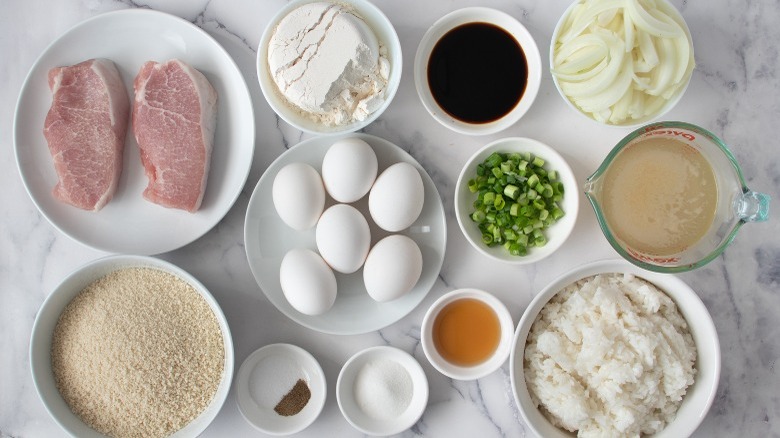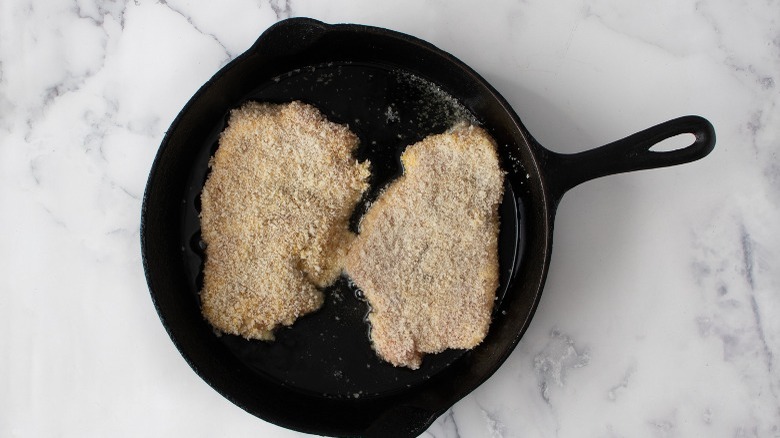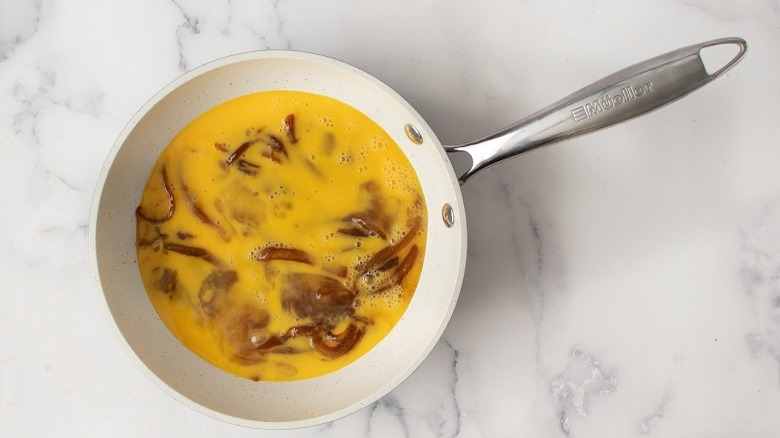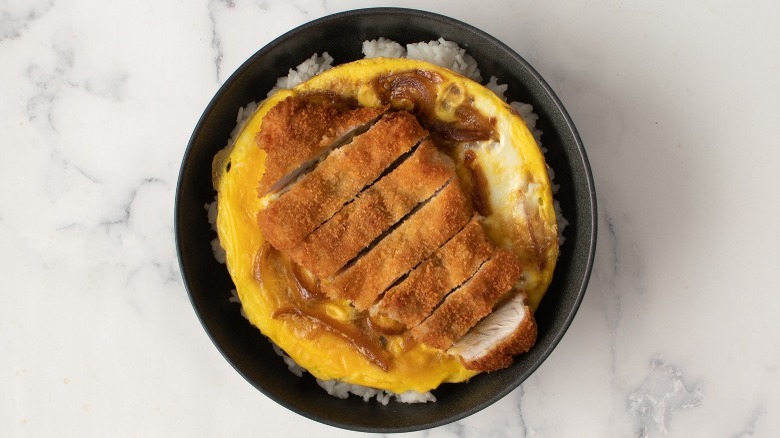Katsudon (Japanese Pork Cutlet And Omelet Rice Bowl) Recipe
Recipe developer Patterson Watkins brings us this recipe for a Japanese pork cutlet and omelet rice bowl, otherwise known as Katsudon. Watkins notes, "Katsudon is an all-day, every-day kinda meal. Don't let that omelet component trick you into thinking this is a 'morning only' meal. Katsudon is one of the many Japanese donburi-style dishes, (donburi meaning 'rice bowl') that you'd see served at casual restaurants or made at home."
While fried crispy foods are some of the most delicious foods out there, this dish embraces a little sogginess. Trust us, this is desired. Traditionally, the flavorful dashi broth makes this Japanese dish a little soggy. This dish combines fried pork cutlets, flavorful sweet and savory broth, and an oniony egg omelet.
Not sure what to pair this with? Watkins recommends, "In Japanese restaurants, this dish might be served with a little side of broth (either miso or dashi) and maybe some pickled vegetables. I personally like to pair my katsudon with either a frosty Sapporo beer or whiskey highball."
Gather your ingredients for katsudon
To make katsudon, or Japanese pork cutlet and omelet rice bowl, you can start by gathering your ingredients. For this recipe, you will need boneless pork chops, salt, pepper, flour, eggs, panko bread crumbs, dashi broth, soy sauce, mirin, sugar, onion, cooked white rice, and scallions.
Prepare and bread pork chops
First, you will start by preparing your pork chops. Pat the pork chops dry and then pound them out until they are evenly about ½ inch thick. Next, season them well with salt and pepper. Then, bread each pork cutlet in flour, then egg, then breadcrumbs. Preheat your skillet with vegetable or canola oil and fry each pork chop for 3 to 4 minutes on each side. Set the golden brown pork cutlets aside on a wire rack to allow excess oil to drain off.
Fry up the omelet
While the pork is resting, fry up the omelet. In a medium bowl, add the dashi, soy sauce, mirin, and granulated sugar before whisking to combine. Using the same skillet, drain off half of the oil and add the onions. Sauté the onions until they are lightly browned, which takes about 4 minutes. Then, add the dashi mixture to the eggs and continue to cook for another 4 minutes.
The sauce should reduce by half and the onions will caramelize and become tender. Add ¼ cup of the sauteed onions to a small skillet and warm over medium-low heat. Then, add in two beaten eggs and cook for about 2 minutes, until the omelet is slightly firm with slightly raw egg on the top.
Plate up rice, omelet, and pork cutlet
Add one of the pork cutlets on top of the omelet and allow to cook for 2 additional minutes. Repeat with remaining pork, onions, and eggs. Then, plate each serving over a scoop of cooked rice and sprinkle with sliced scallions. Wanting to save leftovers? Watkins notes, "Unfortunately, leftovers do not hold up as well as straight-from-the-skillet katsudon. But! You can save some steps for later assembly. The tonkatsu (crispy pork cutlet) can be prepped, cooked, cooled, and reheated (I recommend reheating in the oven or toaster oven on a wire rack until crispy). The onion mixture can also be made ahead, cooled, and added to the nonstick skillet when you're ready to make the omelet."
Katsudon (Japanese Pork Cutlet and Omelet Rice Bowl)
Make this katsudon, or Japanese pork cutlet and omelet rice bowl, any time of day and enjoy it with extra broth or an ice cold Sapporo beer.

Ingredients
- 2 boneless pork chops
- 1 teaspoon salt
- ½ teaspoon black pepper
- 1 cup all-purpose flour
- 6 eggs, divided
- 2 cups panko bread crumbs
- ½ cup dashi broth
- 2 tablespoons soy sauce
- 1 tablespoon mirin
- 2 teaspoons granulated sugar
- 1 ½ cups sliced yellow onion (approximately 1 large yellow onion)
- 2 cups cooked white rice
- ¼ cup chopped scallions
Directions
- Pat pork chops dry with paper towels and place them in a large zipper bag. Using a meat mallet, pound the chops into even cutlets, approximately ½-inch thick.
- Remove the pork cutlets from the bag, transfer them to a plate, and season on both sides with salt and pepper.
- Prepare your breading station by placing flour in one shallow bowl, 2 eggs (beaten) in another bowl, and panko bread crumbs in a third.
- Working in batches, coat the pork cutlet in flour, then dip it in the egg, letting any excess egg drip off before coating it in breadcrumbs. Using your hands, gently press the breadcrumbs onto the cutlet, adhering to the coating. Set the breaded cutlets aside to rest while you preheat the oil.
- Fill a large skillet about a quarter full with oil and bring to 350 F over medium-high heat. Once the oil is hot, carefully place the cutlets into the skillet, and fry for 3 to 4 minutes per side or until cooked through and golden brown. Remove from the skillet and set aside to drain on a wire rack-lined baking sheet. Let rest for 5 minutes before slicing.
- While the pork cutlets are frying, place dashi, soy sauce, mirin, and granulated sugar in a medium bowl, whisk to combine, and set aside.
- Carefully remove half of the oil from the skillet, add the onions, and sauté until tender and lightly browned, about 4 minutes.
- Add the liquid mixture to the skillet, stir to combine with the onions, and continue to sauté for another 4 minutes or until the sauce has reduced by half and the onions are caramelized and tender. Remove from the heat and set aside.
- Place ¼ cup of the onions in a small (6-inch or 8-inch) nonstick skillet and warm over medium-low heat.
- Add two beaten eggs to the skillet and cook for 2 minutes or until the omelet is slightly firm with just a little raw egg on the surface.
- Place one of the sliced cutlets on top of the omelet and continue to cook for another 2 minutes or until the egg is firm and the omelet easily slides around (or releases from) the nonstick skillet. Repeat with the remaining onions, eggs, and cutlet.
- Divide the cooked rice between bowls and top each with the cutlet-omelet combination. Before serving, sprinkle with chopped scallions.
Nutrition
| Calories per Serving | 1,221 |
| Total Fat | 29.6 g |
| Saturated Fat | 9.0 g |
| Trans Fat | 0.2 g |
| Cholesterol | 588.7 mg |
| Total Carbohydrates | 158.7 g |
| Dietary Fiber | 6.3 g |
| Total Sugars | 10.8 g |
| Sodium | 1,839.9 mg |
| Protein | 71.6 g |





